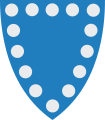Randaberg
| Randaberg kommune | |||
|---|---|---|---|
| Municipality | |||
 | |||
| |||
 | |||
| Coordinates: 59°0′6″N 5°36′55″E / 59.00167°N 5.61528°ECoordinates: 59°0′6″N 5°36′55″E / 59.00167°N 5.61528°E | |||
| Country | Norway | ||
| County | Rogaland | ||
| District | Jæren | ||
| Administrative centre | Randaberg | ||
| Government | |||
| • Mayor (2008) | Tone Tvedt Nybø (KRF) | ||
| Area | |||
| • Total | 25 km2 (10 sq mi) | ||
| • Land | 24 km2 (9 sq mi) | ||
| Area rank | 1337 in Norway | ||
| Population (2009) | |||
| • Total | 9,867 | ||
| • Rank | 114 in Norway | ||
| • Density | 377/km2 (980/sq mi) | ||
| • Change (10 years) | 12.7 % | ||
| Demonym | Randabergsbu[1] | ||
| Time zone | CET (UTC+1) | ||
| • Summer (DST) | CEST (UTC+2) | ||
| ISO 3166 code | NO-1127 | ||
| Official language form | Neutral | ||
| Website | www.randaberg.kommune.com | ||
|
| |||
| Historical population | ||
|---|---|---|
| Year | Pop. | ±% |
| 1951 | 2,116 | — |
| 1961 | 2,884 | +36.3% |
| 1971 | 4,709 | +63.3% |
| 1981 | 6,170 | +31.0% |
| 1991 | 7,681 | +24.5% |
| 2001 | 8,762 | +14.1% |
| 2011 | 10,061 | +14.8% |
| 2021? | 11,633 | +15.6% |
| 2031? | 12,810 | +10.1% |
| Source: Statistics Norway.[2] | ||
Randaberg is a municipality in Rogaland county, Norway, located just to the north of Stavanger. Randaberg was separated from Hetland on 1 July 1922. The northernmost conurbation of Stavanger/Sandnes can be found here.
General information
Name
The municipality (originally the parish) is named after the old Randaberg farm (Old Norse: Randaberg), since the first church was built there. The first element is the plural genitive case of rönd which means "edge", "brink", or "verge" and the last element is berg which means "mountain" ; however, the meaning of berg could also be "rock", or "cliff".
Coat-of-arms
The coat-of-arms is from modern times. They were granted on 26 June 1981. The arms show fourteen silver coins on a blue field. The arms are partly canting since the name is derived from rond which means "edge" and the coins are placed around the shield. The coins symbolize the ball-shaped stones found in large amounts on the beach in Randaberg.[3]
History
Some of the first inhabitants of Norway settled here, and it is believed that the first people came here around 12,000 years ago. It is thought that Svarthola (a.k.a. Vistehålå) was the main shelter for a group of 25 persons, from around 6000 BC. These people were mainly gatherers and hunters, but from around 4000 BC they also started farming. From around 2000 BC, their main activity was farming.
Economy
Randaberg is still an active agricultural community, and produces over 80% of Norway's parsley. The first potatoes every year are grown here, and are given to the Royal Family of Norway. However, there are three suburbs where most people live: Sentrum (310 houses), Viste Hageby (315 houses), and Grødem (135 houses).

Attractions
During the summer the beaches here are very popular, and among the finest in the area around Stavanger. This includes Sandestraen and Vistestraen. Hålandsvannet, a small lake, is also a popular place for swimming.
References
- ↑ "Personnemningar til stadnamn i Noreg" (in Norwegian). Språkrådet.
- ↑ Projected population - Statistics Norway
- ↑ Norske Kommunevåpen (1990). "Nye kommunevåbener i Norden". Retrieved 9 October 2008.
External links
 Media related to Randaberg at Wikimedia Commons
Media related to Randaberg at Wikimedia Commons The dictionary definition of Randaberg at Wiktionary
The dictionary definition of Randaberg at Wiktionary- Municipal fact sheet from Statistics Norway
 Rogaland travel guide from Wikivoyage
Rogaland travel guide from Wikivoyage

